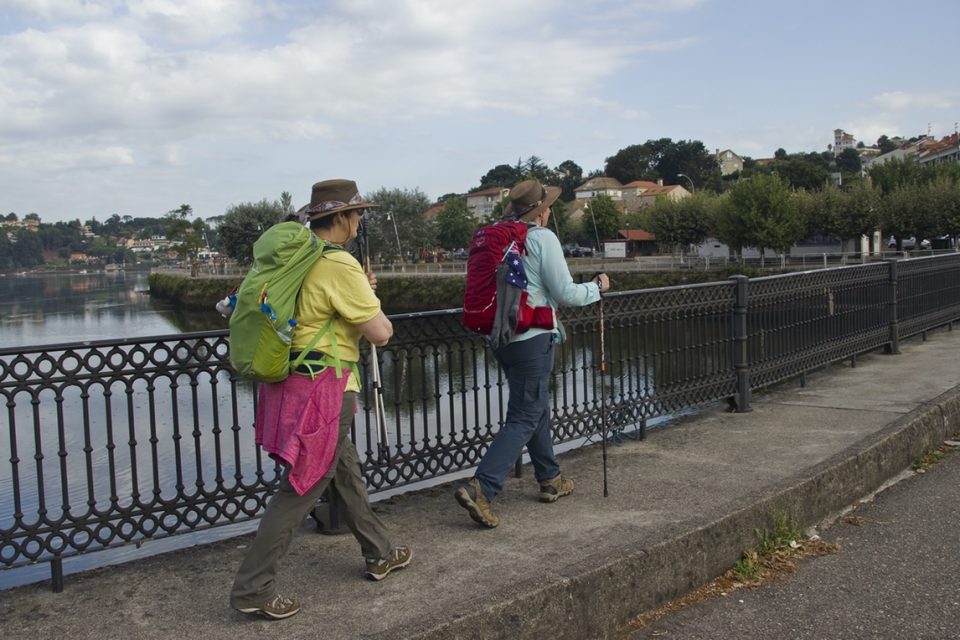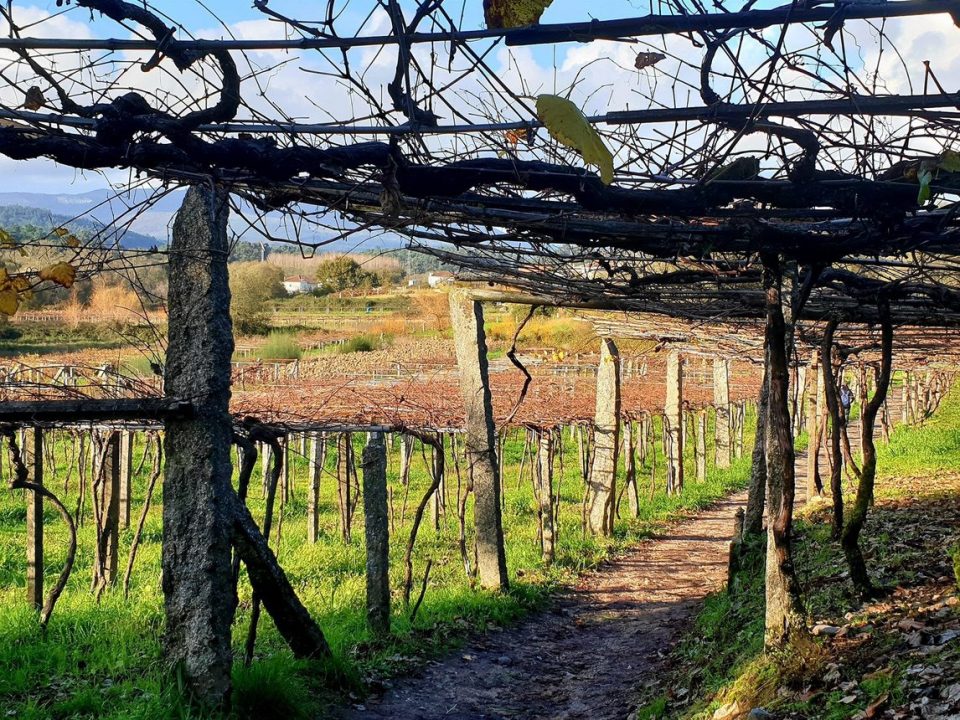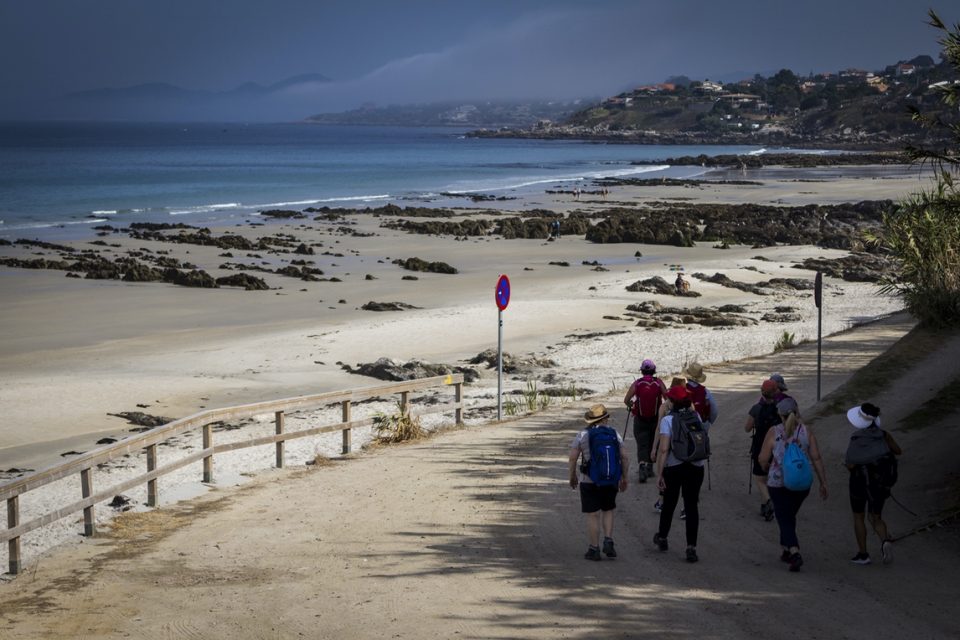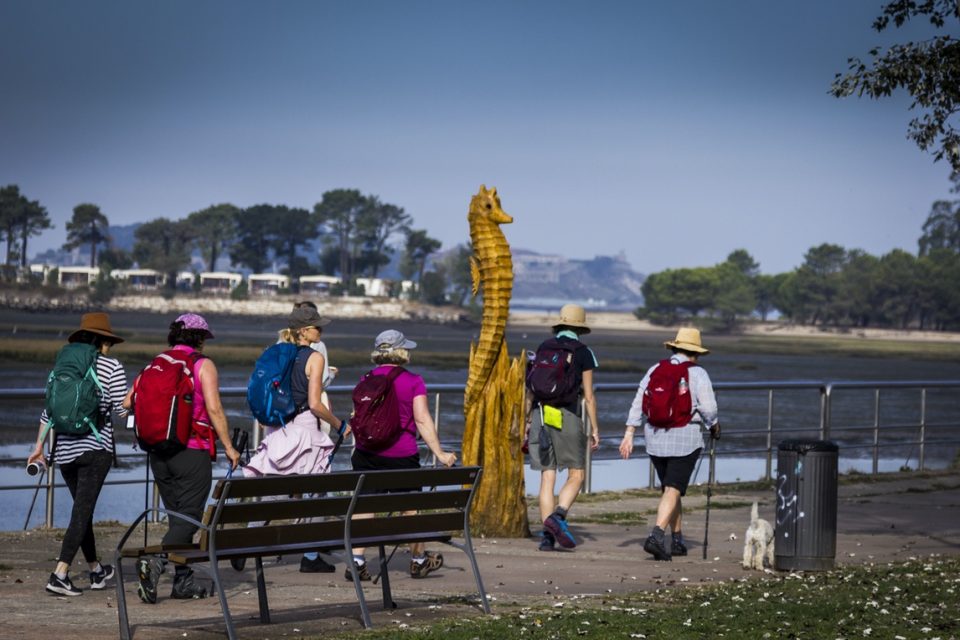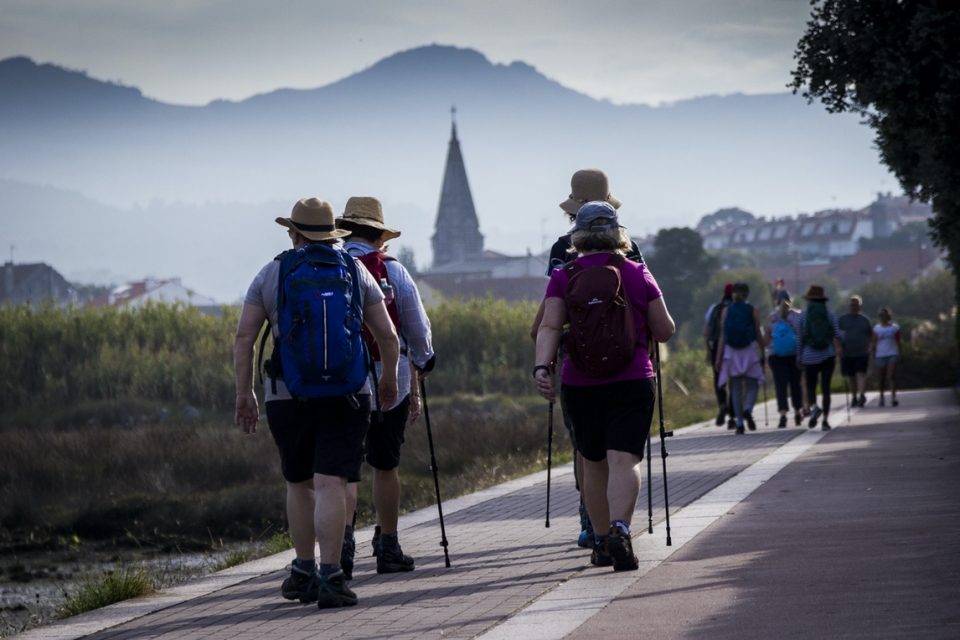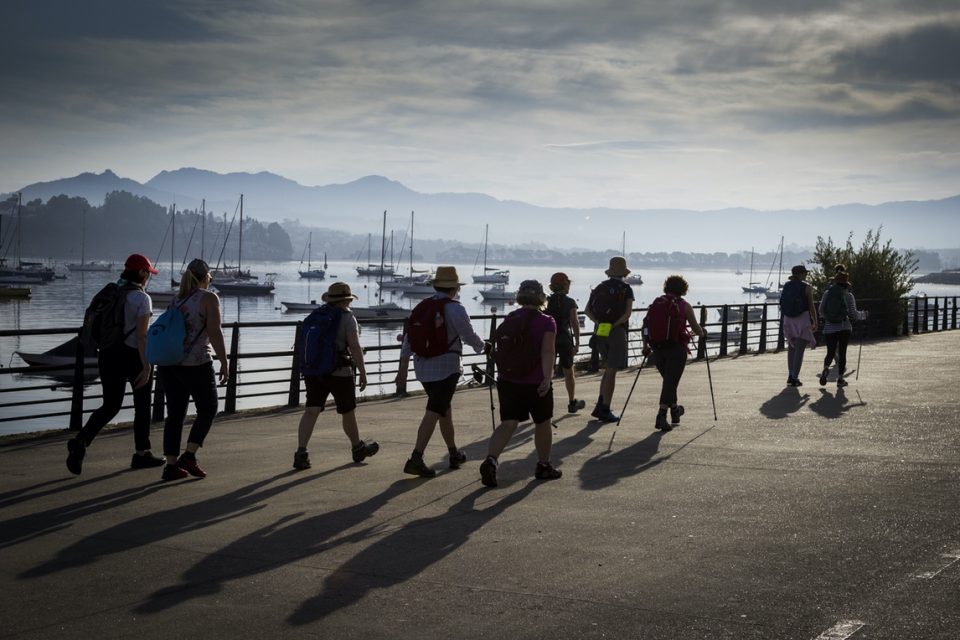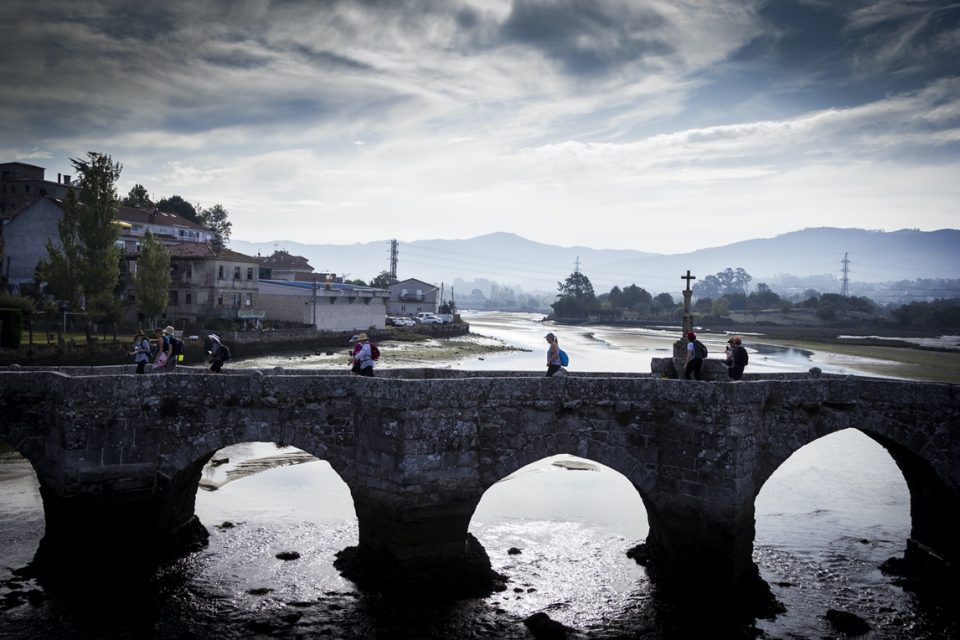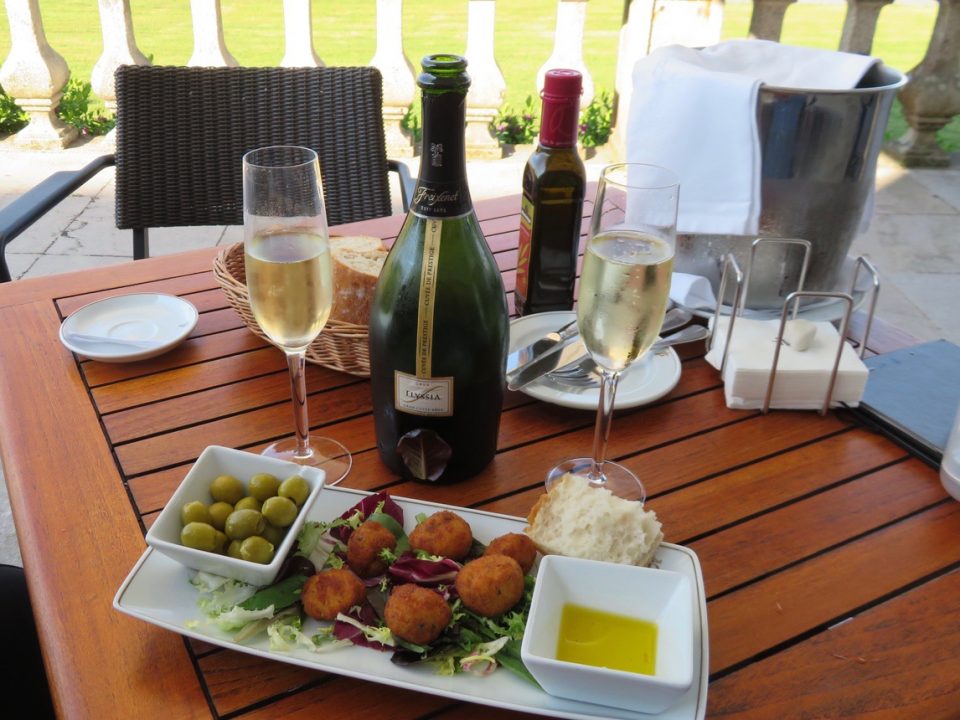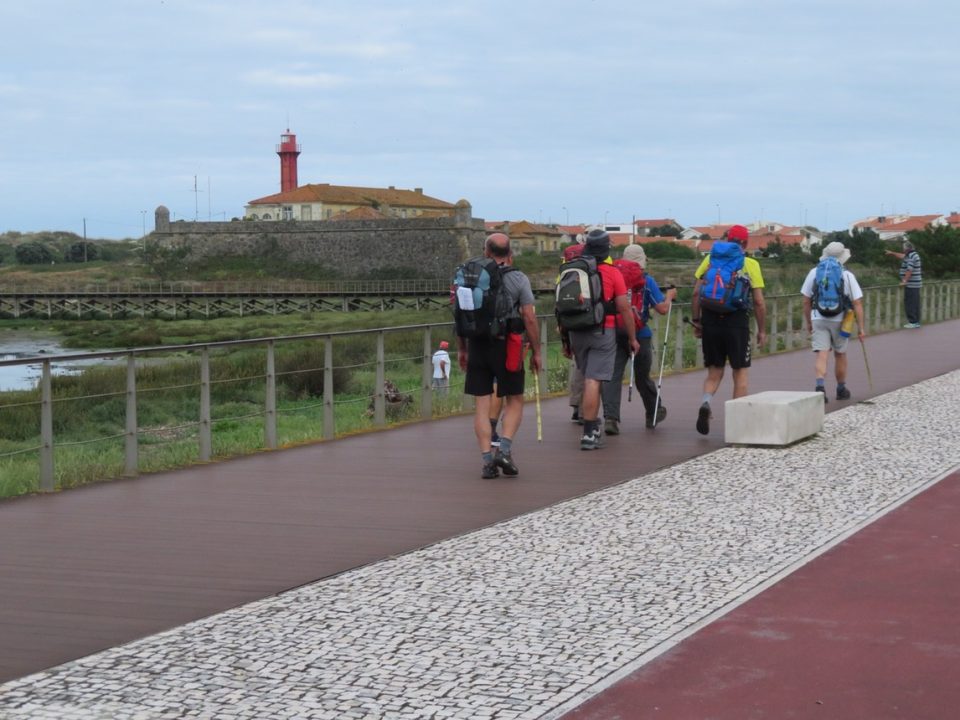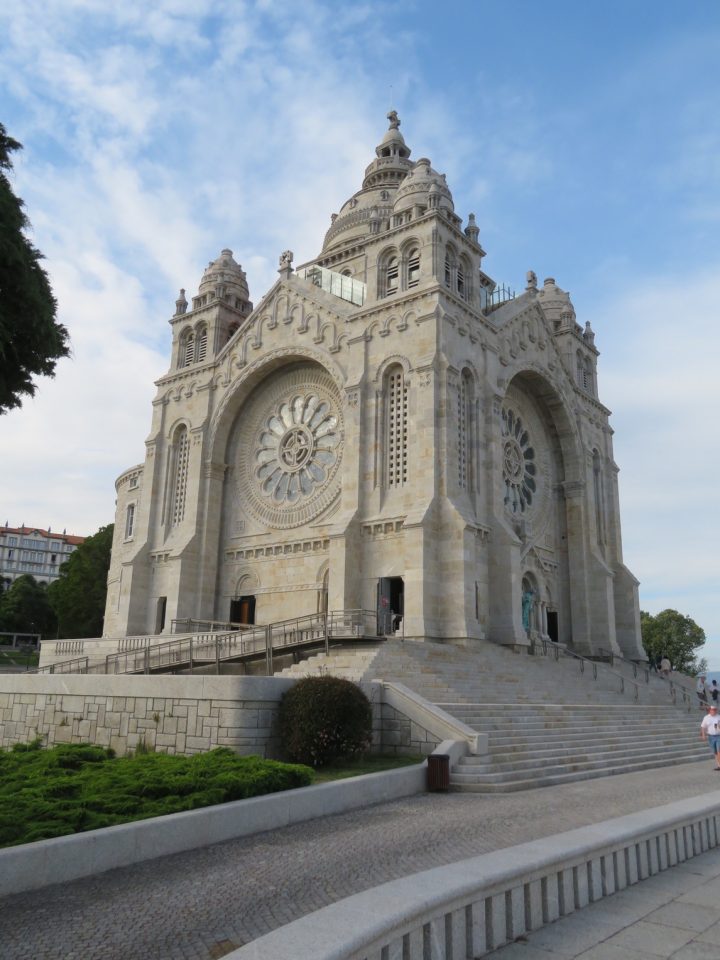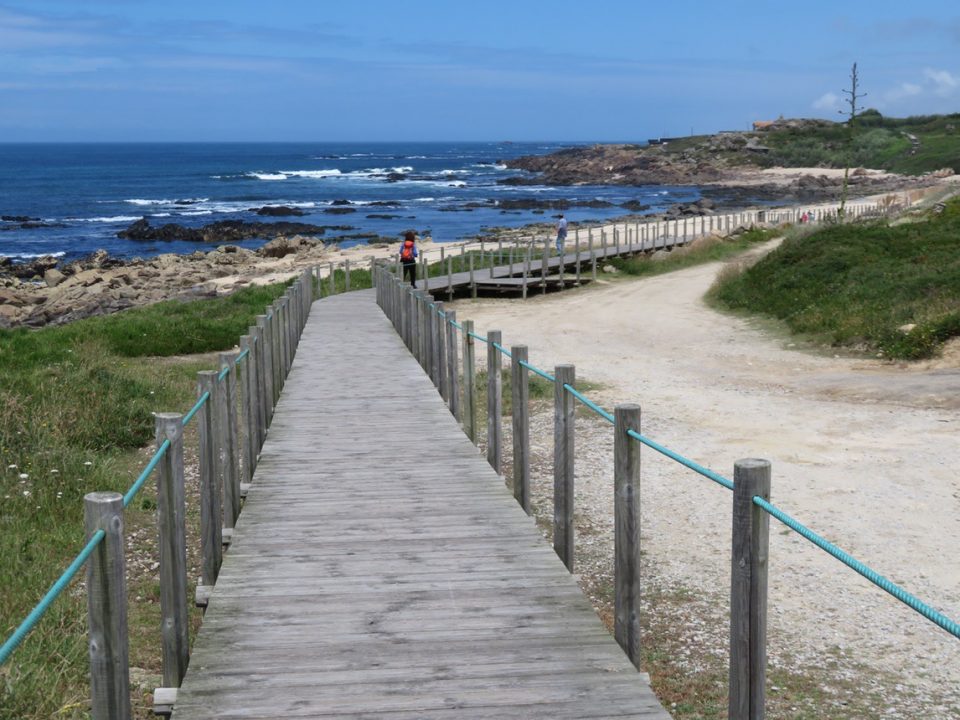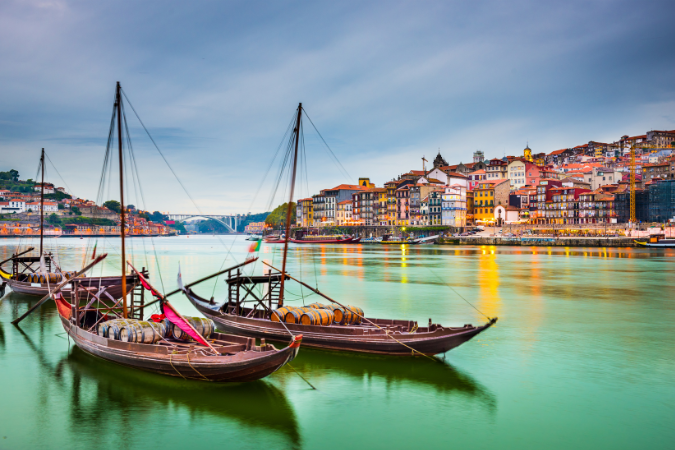length
15 Days
difficulty
Moderate
trip cost
From $1995 pp
Nature Immersion
Cultural Interest
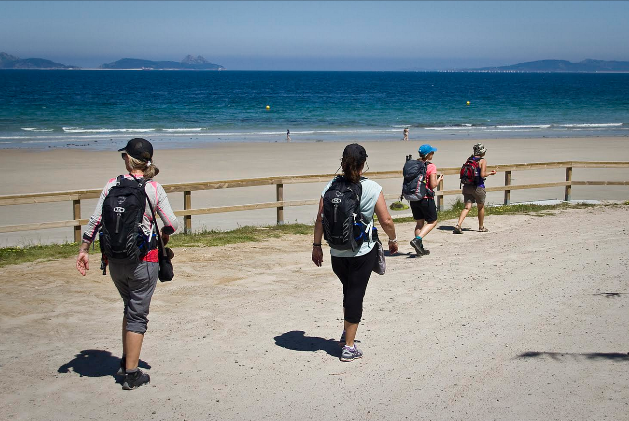
Highlights
get ready for
- A faster paced trip with coastal and rural scenery with abundant history
- Add an extra night or arrange your own additional accommodation
- Modest, well located, clean, comfortable hotels with private bathrooms
- Luggage transfers, breakfasts and in-country support staff
Itinerary
DAILY DETAILS
Start your journey towards Camino de Santiago in Porto, one of the most ancient cities in Europe. Home to 240,000 people, Porto charms visitors with many architectural highlights, the picturesque Ribeira river front and UNESCO heritage listed colourful historic old town. You can easily spend a few days here. There’s a mix of the old and the new with churches, colourful markets, wine bars, port cellars and a lively atmosphere to soak up and enjoy. Be sure to visit the Porto Cathedral before tomorrow’s walk and obtain your first stamp (carimbos in Portuguese and sello in Spanish).
The Coastal Camino from Porto is marked with the blue-and-yellow or rusty steel signs with the familiar scallop shell and the words Caminho Portugues da Costa, and a variety of yellow arrows and scallop shell signs.
On this Camino you have the option of using a mixture of the Senda Litoral (Seashore Path) and Coastal Way; the latter is often slightly inland of the Seashore Path. (Both routes often converge and share the same path.) The Seashore Path is less waymarked, often without any signs.
The day begins by taking the Metro light rail to Matosinhos to avoid the outskirts of Porto and reach the coast to start your walk on the Portuguese Seashore Path (or instead you may prefer to take a 15-minute taxi ride to Matosinhos). If taking the Metro, get off at the ‘Mercado’ stop, 30 minutes from the Trindade Metro station in Porto. Cross the bridge and turn left towards the coast.
Today’s walking is flat and easy. You will be accompanied by many kilometres of golden sandy Atlantic beach, which will be your guide to the town of Vila do Conde. The route along the coast from Matosinhos is well marked. Your walk will be close to the coast, on the pedestrian pavement, the cycle track and wooden walkways, passing fishing villages, chapels, monuments and beautiful popular sandy beaches.
Ignore any yellow Camino arrows directing you to the right to the Coastal Way further inland. Keep to the shore and cross the bridge over the River Ave to enter the medieval shipyard town of Vila do Conde with its pretty harbour and imposing Convent of Santa Clara.
Take time to visit the Museum of Naval Construction with a replica Portuguese carrack, the Nau Quinhentista, floating in the dock. Also, the Igreja Matriz church with the large aqueduct behind it and the Convent of Santa Clara.
Leaving Vila do Condo, with the beach once again on your left, walk along the coastal path to Póvoa de Varzim, a popular resort and holiday town.
Note: The alternative Coastal Way travels up to 5km inland after leaving Porto, through soulless stretches of industrial built-up areas, along busy roads and passing the airport runway until after some 20km, finally enters rural areas near Labruge, 10km before Vila do Conde.
Meals: B
Continue on your way to the old fishing village of Esposende with the Seashore Path and Coastal Way sharing much of the route. Follow the coast passing through the villages of Agucadoura and Areia, then cross through the Coastal Natural Park (Parque Natural do Litoral Norte). At the church in Apulia you have a choice. The Coastal Way forges straight ahead through the pine and eucalypt forest before Fao, while the Seashore Path turns left to follow the coast. Both routes re-joining to cross the River Cavardo on the spectacular bridge before arriving at Esposende, a popular resort and fishing town on the estuary.
Meals: B
Today there is a choice of walking the traditional Coastal Way along quiet roads that continue slightly inland from the coast via the villages of Marinhas, Belinho, Santiago and Chafe to Viana do Castelo, which is reached after crossing the River Lima on Eiffel’s old iron bridge. The alternate route is to take the Seashore Path along the coastal roads, walkways and the beach. Both paths converge at the Ponte Sebastaio Bridge over the River Neiva, about half way between Esposende and Viana do Castelo, before diverging again. So if you prefer, you can mix your day between the quiet rural Seashore Path and the more undulating Coastal Way through the many interesting local communities. While the Coastal Way is well marked, the Seashore Path is not.
Classified as a mecca of architecture, Viana do Castelo is famous for its monuments in and around the city, and the surrounding natural beauty of its beaches and seafront. Take the opportunity to visit the 15th-century cathedral and take the funicular to the Basilica de Santa Lucia on the hill above the town for some of the best views of the West Atlantic coast.
Meals: B
Today’s walk will continue along the wild Atlantic coastline following the official route of the Coastal Way, which is a little inland, passing a world of old farms and quaint villages on narrow cobblestone roads offering beautiful views over the hills and coastline. It’s also possible to walk the Seashore Path along quiet roads, the beach and boardwalks above the dunes, but you will not have the benefit of any way marking. Both routes converge at the old fishing village of Vila Praia de Âncora, your stop for the night. The town has a great beach and is popular with tourists.
Meals: B
Today depart Âncora following the Caminho Portugues da Costa waymarks along the wide concrete walkway and cycle path. Pass the small chapel of Santo Isidoro following the concrete path around to the left and continuing along the shore towards Caminha. Remain on the Seashore Path next to the rocky then sandy coastline; ignore the crossing to the right under the railway line and continue past Moleda beach all the way into Caminha by walking along the path along the Minho estuary. Interesting sites to explore in Caminha are the Torre do Relogio clock tower, the
When ready, take the ferry across the river Minho to A Pasaxe in Galicia. There are about 10 crossings per day from Caminha to A Pasaxe (the schedule varies depending on the season). If the ferry is not running due to low tide, maintenance or being a Monday, you can arrange a boat across using Taximar at the ferry terminal (prices will depend on number of passengers). Once across the estuary in Spain, don’t forget to put your watch forward 1 hour. As an option, on leaving the ferry, instead of walking directly to A Guarda, consider the scenic walk around the peninsular to enjoy an alternative way to enter the town; this will add an extra 3km but is worth it for the fine views.
The fishing port of A Guarda with its pretty harbour is home to Galicia’s most impressive ancient Celtic settlements: the Santa Tecla on the hill above the town – an authentic archaeological gem with breathtaking views of the Atlantic Ocean.
Meals: B
Enjoy a leisurely morning exploring A Guarda before departing by walking past the harbour to the small fort near the breakwater and continue north on the path on the coast. After several kilometres the route joins a wide pedestrian and cycle path above the rocky shoreline along the side of the main road, PO-552, most of the way into Oia. This section is flat with very little shade. As you approach Oia you will be rewarded with the spectacular view of the 12th-century Monastery of Santa Maria de Oia cross the small harbour. Oia is a small pretty town with several restaurants; you may find some locals engaged in an impromptu sing along with bagpipes playing typical Galician tunes.
Meals: B
Start the day by taking the path alongside the dramatic coast where after several kilometres it once again joins alongside the busy PO-552. Just before reaching As Marinos, 11.5km from Oia, the Coastal Way crosses the main road to the right and heads inland and upwards towards Baredo along the old Roman ‘Royal Path’. Look for a small granite Camino sign on the right-hand side of the road near some houses where there will also be a large blue sign. Go through a gate and up the hill; soon you will be rewarded with spectacular views over the coast, the lighthouse and the rocky hill known as Monte de Baredo. Note the prominent wheel ruts worn into the granite rocks as this ancient path goes through the forest and over the pass.
After passing a sports ground, the path enters the village of Baredo and then O’Sinal where you will soon be rewarded with views of the Cíes Islands out off the Bay of Vigo.
Follow the yellow arrows to Baiona and enter the town making your way to the main esplanade along the sea where the imposing walls of the old fortress containing the Parador Hotel can be seen on the small promontory. Baiona is the most popular seaside tourist town in southern Galicia and has a well preserved old town and numerous important monuments. It was here in 1493 that the Caravel La Pinta returned with news of the discovery of America by Columbus. A replica is moored in the harbour. Baiona itself has many great cafes and restaurants and a wonderful atmosphere with an interesting old quarter worth exploring.
Meals: B
Today the best option out of Baiona is to follow the Senda Litoral Seashore Path and cross the medieval Ponte Ramallosa bridge over the Rio Minor. At this point you can decide to either continue along the coast on the Seashore Path, or follow the inland route through the hills on the Coastal Way. The Seashore Path follows coastal roads, promenades, wooden walkways and beaches to the Rio Lagares where it enters the Bay. Here, either continue along the coast into Vigo Baja past the port and docks or take the path alongside the river joining up with the inland Coastal Way and continuing on to Vigo Alto.
From Ponte Ramallosa the Coastal Way goes over the hills with the PO-552 to the left, on back roads and some forest; the path becomes more urbanised closer to the large busy and cosmopolitan city of Vigo. Follow the yellow arrows. There are several Camino routes into Vigo, so you may also encounter green arrows. Make you way to your accommodation in Vigo Baja down the busy and straight Rua de Urzaiz. Vigo is a huge industrial city, so when walking in here expect industrial areas, highways and busy roads; navigating your way may become difficult.
There is an option to have a rest day in Vigo and from here you can take a ferry trip out to the Cíes Islands, which are known as the Caribbean of Spain and are a beautiful protected national park (the ferry runs from June to September and on weekends in May). However, visitor numbers to the islands are controlled, so a visit must be booked in advance.
Meals: B
There are two ways to depart Vigo: the Seashore Path leaves the old town along the coast past the Vigo Guixar railway station along Rua do Areal and Rua de Garcia Barbon and Sanjurio Badia (the PO-323), before turning right (4km from the railway station), on to Camina Trapa where it joins the Coastal Way.
The alternative is to make your way from the old town along the Rua do Principe mall continuing along the Rua de Urzaiz where it intersects with Avenida do Alcalde Gregorio Espino. This is where you pick up the Camino Coastal Way and the yellow arrows. Follow the pedestrian mall then turn to the left just before the ends on Rua Toledo, then along quiet back streets with the Bay of Vigo on the left where the British sunk many galleons in the 1702 battle of Vigo Bay.
The Camino to Redondela is a pleasant walk with great views of the Vigo estuary as the walk continues through a string of hillside villages and patches of woodland. Your stop for the night is the town of Redondela, known as the ‘Village of Viaducts’, where the Coastal and Senda Litoral Caminos join with the inland Central Portuguese Camino to Santiago de Compostela.
Meals: B
Today is a beautiful day of walking. As you walk on the Camino Portuguese you will notice many more pilgrims who have joined from the Central Way from Porto via Tui. Several kilometres out of Redondela the path leads up to the Alto de Lomba through the forest after which there is a short section on the busy N-550 to the village of Arcade famous for the best oysters in Galicia. Cross the long medieval bridge of Ponte Sampaio over the River Verdugo where Napoleon’s army was defeated by the Spanish in 1809 during the War of Independence. Then walk up through the forest and enjoy one of the most beautiful stretches of the Camino following the ancient narrow stone paths as they climb up the slope. The path widens amongst fields and vineyards, arriving at Pontevedra with its pretty historic centre, 13th-century church of Santa Maria, and the famous Pilgrim Virgin’s church (Santuario da Peregrina), which although appears round, is actually in the shape of a scallop shell.
An alternative scenic and peaceful way to enter the town is via the Rio Gafos. Turn left shortly after the chapel da Santa Marta and before a play area, not waymarked.
Pontevedra is another good rest day option as it has a wonderful atmosphere to soak up and enjoy with its pedestrianised streets and plazas.
Meals: B
Today the Camino Portuguese will take you over the Rio Lerez via the pretty stone Ponte do Burgo bridge decorated with scallop shells and through chestnut groves and pine and eucalyptus trees to the village of San Amaro. Emerging from the woods near Valbon, at the Cruceiro de Amonisa, a statue of Saint James with his walking stick points the way to Santiago. You will pass the pretty village of Tivo with its lovely fountain and public washing area. Continue on through rural fields and vineyards to the Roman-influenced town of Caldas de Reis, known otherwise as ‘the hot waters of the Kings’, where you will find the thermal springs after crossing the river Umia around to the left outside the Hotel Davila. You may wish to soak your feet in the hot thermal water upon your arrival into the town.
Meals: B
Today’s walk is one of the most beautiful of the whole route. The path once again takes you through pine forests and rural areas through the Bermana and Verga valleys to today’s destination across the Ulla River, the town of Padron. Padron, the starting point for Saint James ministry in the Iberian peninsular, was also said to be where his body first reached land when it returned by boat after being martyred in Jerusalem. The parish church has the legendary Pedron, the stone where St James’ boat was moored. You can find the Pedron under the altar in the Igrexia de Santiago with a replica Pedron over the bridge on the west bank of the Rio Sar.
Meals: B
Your final walking day on the Camino Portuguese will provide some variety through woodlands and on increasingly busy roads. You will pass through a number of small villages and the suburbs of Santiago de Compostela. After making your way to the historic sanctuary of A Escravitude, continue to Faramello and the Chapel of San Martino where you can see one of the oldest wayside crosses (cruceiro) in Galicia.
After passing through Milladoiro and the tiny town of Agro dos Monteiros, but before passing under the motorway, pilgrims now for the first time will have a view of the spires of the Cathedral of Santiago de Compostela. After crossing the Sar River, take the left waymarked option and continue through the streets of the city via Rua de Porto Faxeira, the old entrance of the Portuguese Way into Santiago de Compostela. Make your way via Rua Franco to Praza do Obradoiro and the Cathedral of Santiago de Compostela.
Meals: B
You are free to check out of your hotel any time before 10am. If you would like to explore Santiago further you are able to leave your bags with reception.
Meals: B
Map
Explore
Porto
Porto is one of the most ancient cities in Europe. It has many architectural highlights, the picturesque Ribeira riverfront and UNESCO heritage listed colourful historic old town. No visit to Porto is complete without a river cruise to the port wine sellers of the Douro Valley, a UNESCO world heritage wine region. While you’re in Porto, seek out the city’s namesake dish, Tripas à Moda do Porto, and its most popular sandwich, the Francesinha. You’ll easily burn off the calories if you are starting your pilgrimage from this beautiful seaside port.
CLICK ON A PIN TO REVEAL INFORMATION ABOUT THAT LOCATION
Póvoa de Varzim
This is a modern resort and holiday town. The town’s main appeal is the beach. There is also a historic centre and shopping streets.
Esposende
Esposende is a popular resort and fishing town. Along the riverside runs a wide palm-lined boulevard. The broad beach at the mouth of the Cávado River is known for its quality surf. Backed by low dunes the beach is overlooked by the 17th century Forte de São João Baptista and the red metal tower of Esposende lighthouse.
Viana do Castelo
Classified as a mecca of architecture, Viana do Castelo is famous for its monuments in and around the city, and the surrounding natural beauty of its beaches and seafront. You can visit the 15th century cathedral and take the funicular to the Basilica de Santa Lucia on the hill above the town for some of the best views of the West Atlantic coast.
Vila Praia de Ancora
The old fishing village of Vila Praia de Ancora has a great beach and is popular with tourists. The town has an excellent reputation for gastronomy. The festival of the Sea and Sardines is held in early July.
A Guarda
The fishing port of A Guarda has a pretty harbour and Galicia’s most impressive ancient Celtic settlement – the Santa Tecla on the hill above the town is an authentic archaeological gem with breathtaking views of the Atlantic Ocean.
Oia
As you approach the small town of Oia you will see the spectacular 12th-century Monastery of Santa Maria de Oia across the small harbour. The pretty town has several restaurants, and you may find some locals engaged in an impromptu sing along with bagpipes playing typical Galician tunes.
Baiona
Baiona is the most popular seaside tourist town in southern Galicia and has a well preserved old town and numerous important monuments. It was here in 1493 that the Caravel La Pinta returned with news of the discovery of America by Columbus. A replica is moored in the harbour. From Baiona you can travel to the nearby historic town of Tui with its cathedral (a highlight of the inland Central Camino) or to take a ferry trip to the heavenly Cies Islands, which are known as the Caribbean of Spain.
Vigo
Vigo is a busy, cosmopolitan industrial city. The Old Town (Casco Vello) is the city’s heart, packed with lively bars and restaurants serving delicious Galician dishes.
Redondela
The town of Redondela is known as the ‘Village of Viaducts’. It’s where the Coastal and Senda Litoral Camino’s join with the inland Central Portuguese Camino to Santiago de Compostela.
Pontevedra
Pontevedra has a pretty historic centre, pedestrianised streets, plazas and a wonderful atmosphere to soak up. The famous Pilgrim Virgin’s church (Santuario da Peregrina) appears round but is actually in the shape of a scallop shell.
Caldas de Reis
The Roman-influenced town of Caldas de Reis, known as ‘the hot waters of the Kings’. You’ll find the thermal springs after crossing the River Umia.
Padrón
Padrón was said to be where the body of St James first reached land when it returned by boat after being martyred in Jerusalem. The parish church has the legendary Pedron, the stone where St James’ boat was moored. You can find the Pedron under the altar in the Igrexia de Santiago with a replica Pedron over the bridge on the west bank of the Rio Sar.
Santiago de Compostela
The wonderful and historic city of Santiago is the end of the Camino journey for most pilgrims. Praza do Obradoiro and the wonderful ancient Cathedral form the city’s heart. Attend the midday pilgrims mass and watch the steady stream of pilgrims arriving into the square as they finish their epic journey. There are many enticing tapas bars and restaurants in which to celebrate your journey.
Inclusions
What's included?
- 14 nights’ comfortable accommodation
- Private en suite rooms on a twin share basis
- Daily breakfasts
- Luggage transfer each day from hotel to hotel (1 x 20kg bag per person)
- RAW Travel navigation app with maps of your hotel locations and emergency contact numbers
- Local and Australian emergency contact numbers
- Pre-trip Camino guidance and planning
- Dedicated local support person in Spain for reassurance
- Single supplement $1170
- Flights
- Travel insurance
For an extra indulgence, upgrade your hotel in Santiago to a Parador, when booked 6 months in advance (subject to availability) – surcharge available on application.
For any part of your trip that falls between 31 October and 31 March there is an ‘out of season’ luggage transfer surcharge cost of $30 per person per day.
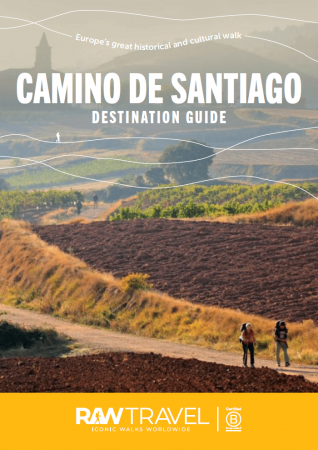
Exclusive Guide
Get inspired
Walking the Camino is an incredible journey that will immerse you not only in Europe’s grand history, food and culture but most importantly the extraordinary camaraderie that exists along these routes. The spirit of the Camino de Santiago is alive and well among people from all over the world. It is a ‘bucket list’ experience you will never forget! Discover inspiration, travel essentials, practical information and more in our free Destination Guide. All you need to know about walking the Camino de Santiago routes through Spain, Portugal and France!
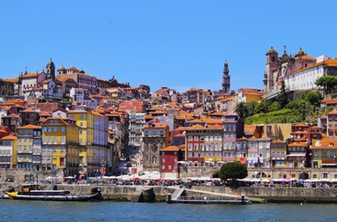
Portuguese Coastal Camino
Porto to Santiago: The Essentials Trip – Portuguese Coastal Camino
- A faster paced trip with coastal and rural scenery with abundant historic relics
- Modest, well located, clean, comfortable hotels with private bathrooms
- Add an extra night or arrange your own additional accommodation
- Luggage transfers, breakfasts, in-country support staff
$1,995.00

Portuguese Coastal Camino
Porto to Santiago: Mountain Bike
-
- Cycle from Porto to Santiago on this quieter Camino route
- Enjoy memorable encounters with friendly locals along the way
- Discover historic towns with a wealth of architectural sites and surprises
- Rest or explore with free days in Porto and Santiago de Compostela
$3,520.00
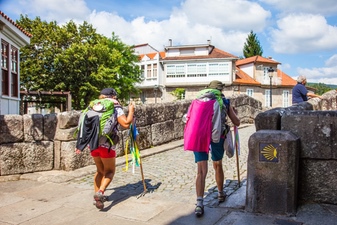
Portuguese Coastal Camino
Baiona to Santiago – Portuguese Coastal Camino
- Beautiful Galician scenery; seascapes, vineyards and shady forests
- Walk approx. 130km enabling you to receive a Compostela
- Local delicacies especially amazing seafood including oysters and pulpo
- Magnificent accommodation with a complimentary upgrade
$1,995.00
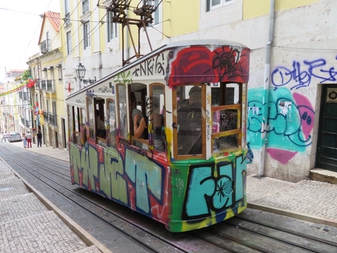
Portuguese Coastal Camino
Lisbon to Santiago – Portuguese Coastal Camino
- Explore Lisbon’s abundant history, fine cuisine and lively culture
- Fresh cod and grilled sardines the world famous ‘Pastéis de Nata’
- Lush fields, olive and citrus groves, beautiful beaches and wild coastlines
- Roman remains, old Knights Templar towns, Moorish bastions
$6,450.00
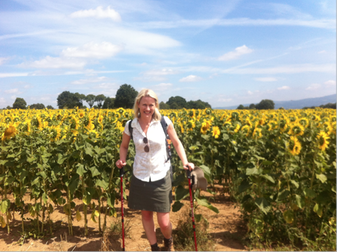
Camino de Santiago
The Camino Stage 3-5. Leon to Santiago: Women’s Trip
- Walking over 300km of the French Camino Trail
- Visit the final end point of your walk at the Cathedral in Santiago
- Self-guided trip; set your own pace, we look after your accommodation and luggage transfers
$3,050.00

Camino de Santiago
The Highlights Trip – Camino
- Walk the best sections of the Camino
- Use trains to visit other cities along the route
- Follow in the footsteps of millions of pilgrims
- Dedicated local support person in Spain
$2,690.00
TRIP date selection
when would you like to travel?
Please select your preferred dates for on-demand trips or select a scheduled date for group departures. If you have booked a self-guided trip please understand that because your trip date is on demand and we must check availability of all properties on your chosen dates before it can be fully confirmed


